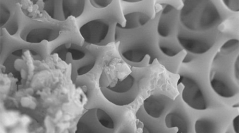

 Comptes Rendus Palevol
6 (1-2) - Pages 103-114
Comptes Rendus Palevol
6 (1-2) - Pages 103-114Middle Eocene siliceous bioaccumulation on Demerara Rise is explored using taphonomic and palaeoecological studies of radiolaria and diatoms, respectively. Enrichment and improved preservation of silica began just above the Lower to Middle Eocene transition (ca. 49 Ma) and was mainly due to radiolarian productivity. It reflects a profound change in the zooplankton communities of the western Equatorial Atlantic, dominated previously by planktic foraminifera. Diatoms are a minor siliceous component of the Middle Eocene chalk. This microflora is dominated by robust planktic species, typical of neritic environments, and includes some upwelling indicators. Benthic species are absent. No continental taxa were recorded. Onset of biogenic silica accumulation was probably due to the establishment of a vigorous bottom current circulation and higher levels of productivity. It coincides with a major palaeoceanographic shift from a Lower Eocene stagnant to a more vigorous Middle Eocene ocean, following some as yet poorly understood global climatic change.
Radiolarians, Diatoms, Demerara Rise, Eocene, Atlantic